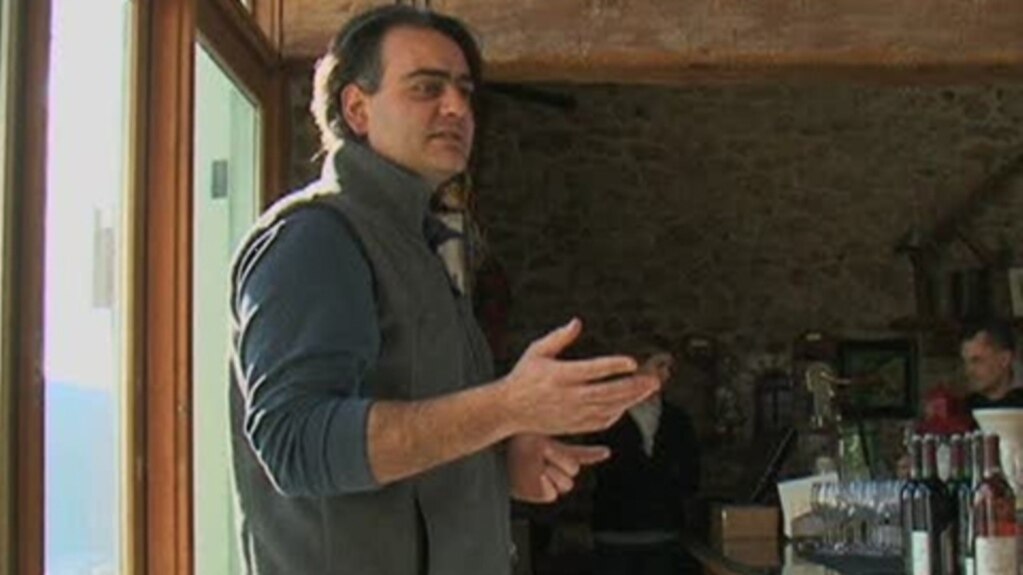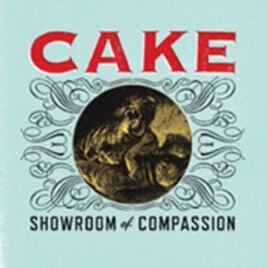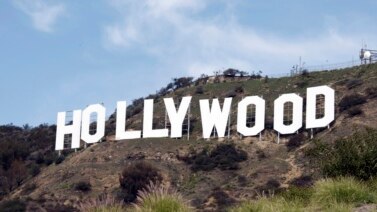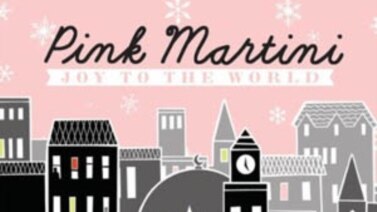
DOUG JOHNSON: Welcome to AMERICAN MOSAIC in VOA Special English.
(MUSIC)
I'm Doug Johnson.
This week we play new music by the band Cake...
And answer a question about New York City...
But first a visit to Virginia wine country.
(MUSIC)
Virginia’s Wineries
DOUG JOHNSON: The economic recession has caused many Americans to cut their spending. But one thing Americans keep buying is good wine. The sales numbers are not fully recorded yet for two thousand ten. But the Beverage Information Group estimates that American wine sales were up for the seventeenth year in a row. And the sales are not all coming from the famed California vineyards. Faith Lapidus has our report from some wineries in Virginia.
FAITH LAPIDUS: Bora Baki owns the Hillsborough Winery in Purcellville, Virginia. The Turkish immigrant opened the company with his son ten years ago. The older man says he had planned on retiring at the time. But his son, Karem, had other ideas.
KAREM BAKI: “I was graduating my college, my undergraduate degree and so we were both looking for something to do.”
Karem Baki went on to get a higher degree in winemaking. Now he and his father make wine for the Hillsborough name but also for other local vineyards. Karem Baki says Virginia is excellent for growing wine grapes.
KAREM BAKI: “With the different regions in Virginia you almost have perfect conditions. We of course have our own issues and complications, but as far as the potential for a grape-growing region it’s quite great.”
Last year about twelve thousand people visited the Hillsborough Winery.
BORA BAKI: “Since we don’t filter our reds, because if you filter the reds you lose the flavors, you are going to have some residue on your glasses. So don’t think it’s dirt, it’s just grape.”
Bora Baki is pouring wine for a group of men and women who climbed a hill in the snow to taste his wine. The winery owner says the recession has not affected his business.
BORA BAKI: “We have a saying in Turkish, I don’t know if you translate this properly: ‘When you are in sorrow, you drink; when you are happy, you drink.’ So even if the economy was bad people find a way of enjoying themselves with a glass of wine.”
Hillsborough was the ninety-sixth winery in the state when it opened in two thousand three. Now, there are almost twice as many across Virginia. They can be found in the mountains, valleys, and all along the coastal area.
Ann Heidig and her husband opened the Lake Anna Winery near the state capital, Richmond, in nineteen ninety. Today she is president of the Virginia Wineries Association.
ANN HEIDIG: “I think the quality of Virginia wines has attracted some larger investors to come in and want to start growing grapes and making wine in Virginia. Even from California we have a couple of people that have come in to start wineries here. So, I think they see it as an opportunity because it is a young industry and it is growing and also it is a viable industry in the state for agriculture.”
Most Virginia wineries are small, producing no more than five thousand cases of wine a year. And sixty percent of that product is sold at the winery itself.
(SOUND)
SALESPERSON: “Your total is $184.”
SHOPPER: “It’s worth every penny.”
Tourism supports the wine industry in Virginia. Pandit and Sudha Patil own Narmada Winery in Amissville. It opened in two thousand nine. The Indian-American couple says many of their customers visit local wineries instead of taking a vacation.
PANDIT PATIL: “People come from all over DC, Northern Virginia and Maryland, Charlottesville and they stop at the wineries, do tasting.”
SUNDHA PATIL: “They may not spend a whole lot of money, but it’s their way to just get out for the weekend.”
Pandit Patil hopes that idea keeps spreading.
PANDIT PATIL: “In five years, I want everybody to think this is a destination.”
Like many wineries in Virginia, Narmada is in a beautiful country setting. And they have live music on the weekend. Narmada visitor Ted Sevigny says the winery also offers something that others do not.
TED SEVIGNY: “You don’t find Indian Virginia wineries. Most of them are Italian or whatever, type of thing, but this one is very unique.”
Sudha Patil agrees.
SUDHA PATIL: “We have a unique thing being of Indian background, that we do. Some of our wines can be paired very nicely with the Indian foods we serve here as snacks.”
(MUSIC)
New York City Culture
DOUG JOHNSON: Our listener question this week comes from Andre Weigel in Brazil. He wants to know about the culture of the people in America’s largest city.
New York City, in the state of New York, is the largest city in the United States. More than eight million people live there. That is more than two times the number of people in Los Angeles, California, America’s second largest city.
New York City is the cultural capital of America. It is an important center for art, architecture, theater, music, dance and film.
New York is also known for its cultural diversity. About thirty-six percent of the people were born in a foreign country. If you asked those people where they are from, they would probably say: The Dominican Republic, China, Jamaica, Guyana, Mexico, Ecuador, Haiti, Trinidad and Tobago, Colombia or Russia. Most new immigrants come from those ten countries. However, about one hundred seventy languages are spoken in America’s largest city.
Many Europeans moved to New York about one hundred years ago. They came mostly from Italy, Ireland, Germany, Russia and Poland. Today, the New York City area has the largest number of Jews outside of Israel. It is also home to more African-Americans than any other American city. Except for Puerto Rico itself, more Puerto Ricans live in New York City than in any other place in the world.
Immigrants often live in communities with other people from their countries. These include communities of Italians, Russians, Chinese, Koreans, Dominicans and Puerto Ricans.

About forty-four percent of all New Yorkers are white. A little over one-fourth are African-American. About one-fourth are Hispanic or Latino. Nearly twelve percent have Asian ancestors.
One thing that all New Yorkers have in common is the density of their city. Millions of people live in a small place. New York City has five boroughs. They are the Bronx, Brooklyn, Staten Island, Queens, and Manhattan.
The island of Manhattan has almost twenty-six thousand people per square kilometer of land. The streets of Manhattan are very crowded because so many people live and work in there. Most people travel in buses, taxi cabs, or underground in the subway instead of owning cars. Most live in tall apartment buildings. Manhattan is home to some of the wealthiest as well as the poorest people in the city.
(MUSIC)
Cake
DOUG JOHNSON: The California-based band Cake released “Showroom of Compassion” last week. It is the band’s first album in seven years. Many fans were expecting greatness. Some are satisfied, others are not.
Mario Ritter has more on Cake and plays songs from the new album.
MARIO RITTER: Cake has been together since the early nineteen nineties. The band has released six studio albums including “Showroom of Compassion.” However, band leader John McCrea told Rolling Stone magazine that he thinks about breaking up with the band every day. He says he likes making music. But he says concerts and selling tee-shirts is the only way to make money in the business. McCrea says that means a lot of airplane travel and pollution. He says he would like a career that is less damaging to the environment.

Cake’s website contains environmental messages and news. The band also completed building a solar-powered recording studio in two thousand eight. The new album was made there.
Here is “Sick of You” from “Showroom of Compassion.”
(MUSIC)
Some critics note that “Showroom of Compassion” sounds a lot like past Cake albums. John McCrea does not have a problem with that. He says he likes Cake’s sound. But he says this album does include slow songs and more piano than usual.
“Got to Move” sounds like traditional Cake.
(MUSIC)
Cake is currently appearing around the United States and Canada. As usual, the band will be giving away one tree to one lucky concertgoer at most shows. Cake hopes this will help influence other fans to plant trees to help the planet.
We leave you with another song from “Showroom of Compassion.” This is “Bound Away.”
(MUSIC)
DOUG JOHNSON: I’m Doug Johnson. Our program was written by Jim Tedder, Susan Logue and Caty Weaver who also was our producer.
Join us again next week for AMERICAN MOSAIC, VOA’s radio magazine in Special English.
(MUSIC)





